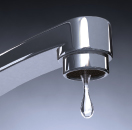 |
 |
|||||||
|
Around the house with Julia  The first step to fixing your leak is to figure out the type of faucet you have. Kitchen faucets come in several basic styles: • Ball-type faucets are single-handled and have a dome-shaped cap or faucet knob. A single-handle pullout faucet has a spray wand that docks in the faucet neck. • Ceramic disc faucets are like ball-type faucets in that they can have single handles. Under the cap, the workings of the faucet are contained inside a cylinder (unlike the many individual internal parts within a ball-type faucet). • Stem faucets always have two handles and can be distinguished from other types of faucets by the way they turn off. You should feel the pressure of a rubber washer being squeezed inside the faucet handles as they turn. • Cartridge faucets are found in both single- and double-handled models and are quite common on kitchens sinks. Once you’ve identified the type of faucet, the next task is to know what part, in the midst of many, is causing trouble. First and foremost, you must turn off the water supply. The shutoff valves will probably be located under the sink, but some older homes might require that the water supply to the entire building be turned off. For two-handle stem faucets, turn off the water to either the hot or cold side first to isolate which side might be leaking. Be sure to include padding like cloth, tape or gauze between every tool and the faucet to protect against scratching or marring the surface. Ball-type faucets Remove the cap and check the valve springs for wear. They may appear compressed or have lost tension. While the faucet is disassembled, it’s a good time to replace the springs. The rubber seat surrounding the springs may also be causing the leak. It’s also a good idea to replace this part now rather than coming back to it later. For convenience, kits are available that include both springs and the accompanying seats. Next, check that the ball valve isn’t worn or damaged – a pitted or eroded ball slot is a dead giveaway. Also, the ball slot should fit snugly around and attach to the faucet body’s pin. Ceramic disc faucets With these faucets, the culprit is usually a dirty cylinder. Remove the cylinder from the faucet body and clean the openings with a pad designed for nonstick cooking surfaces. Next, rinse the cylinder under fresh water. Stem faucets Cartridge faucets If you’ve tried these steps and your faucet is still leaking, it just might be time to invest in that fancy new faucet after all. But it never hurts to try a little troubleshooting first to avoid that costly bill for a plumber’s visit. |
||||||||
 |
||||||||
|
||||||||
 
|
||||||||


